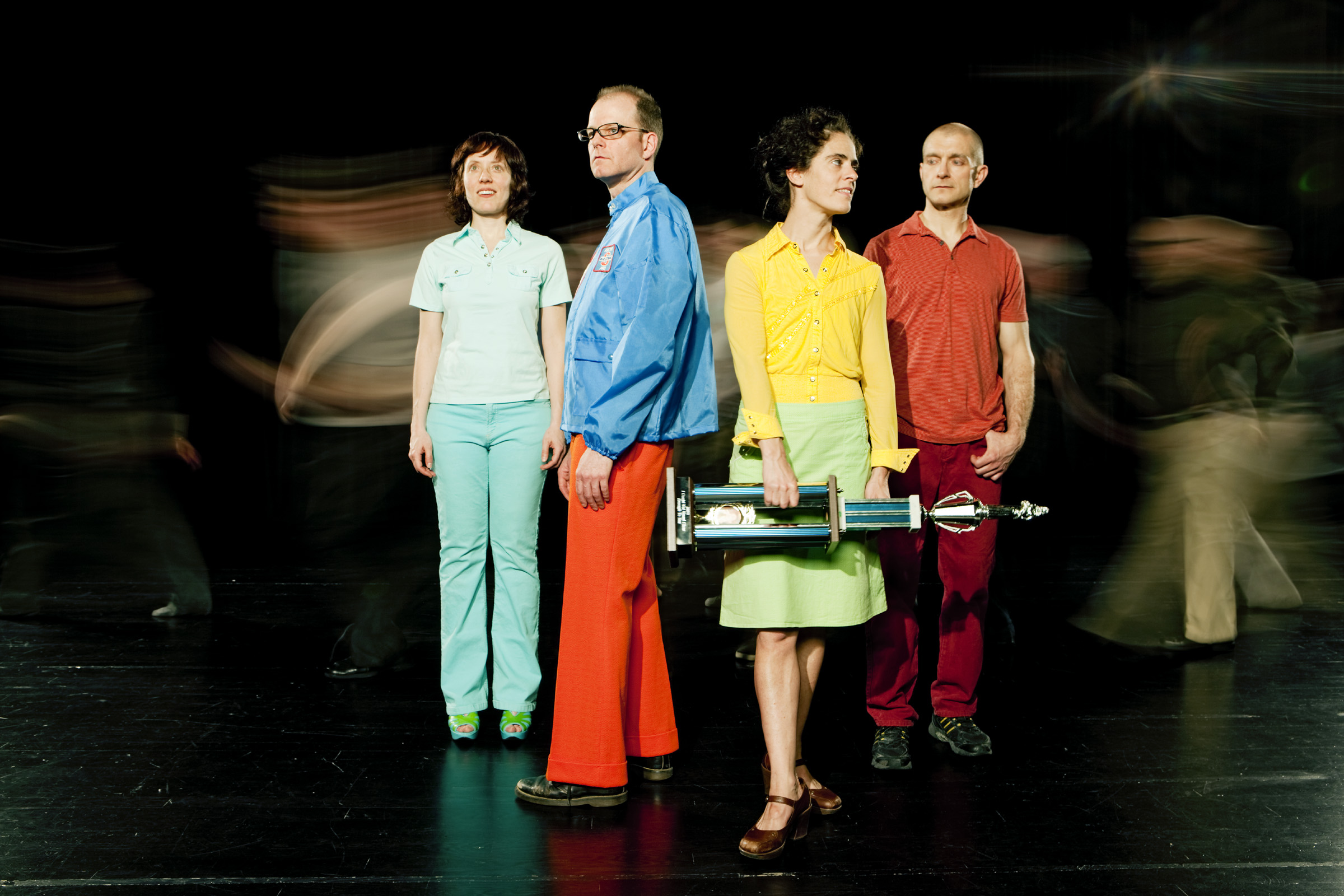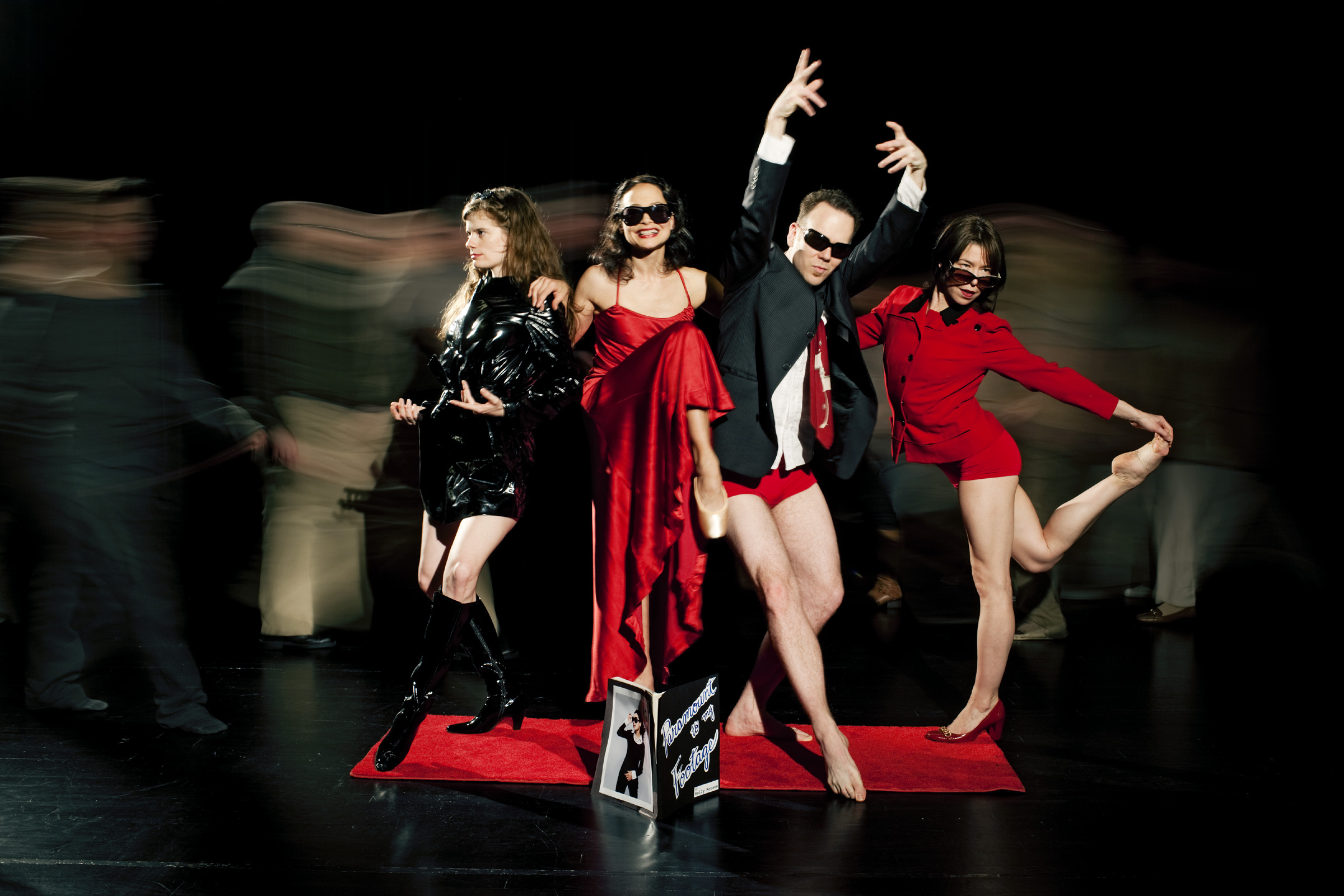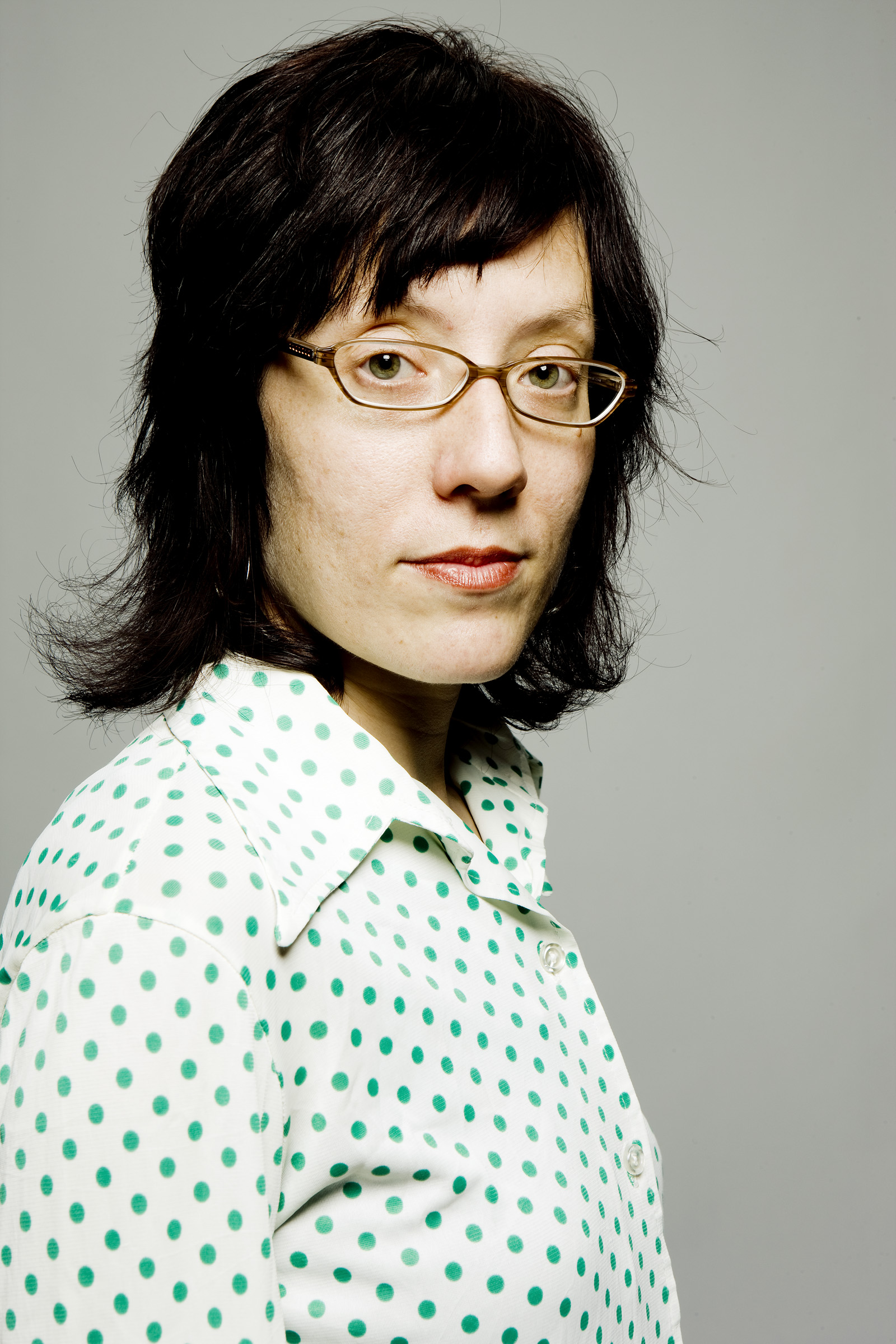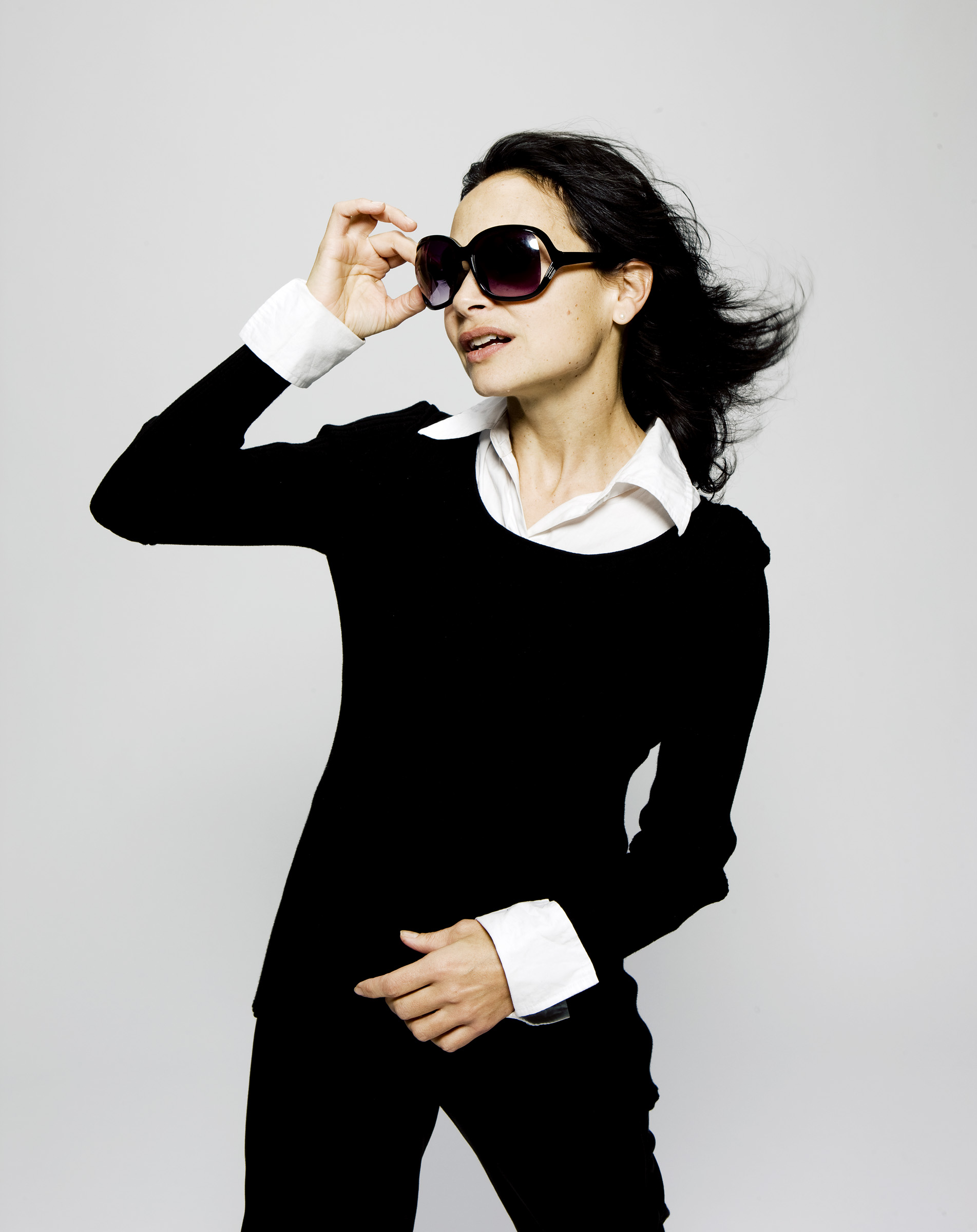MOMENTUM: Sally Rousse and Megan Mayer
In this, the second in her two-part review of this year's MOMENTUM: New Dance Works offerings, Lightsey Darst gives her thoughts on the performances created by Sally Rousse and Megan Mayer.




ONE REASON I START LOOKING FORWARD TO MOMENTUM, as soon as commission recipients are announced in the fall, is the consistent care these artists take in creating their performances. They know this is a big debut, and you can feel their respect for the opportunity in the love they lavish on their work. This was particularly the case with this year’s second pair of choreographers, Sally Rousse and Megan Mayer.
If it’s true that all artwork is to some degree autobiography, why not lift the curtain entirely? From the opening sequence of Sally Rousse‘s Paramount to My Footage — Rousse, in pointe shoes and a tartan cape with a big S on the back, is lifted airborne to repeatedly swing-splat into the giant projection screen where her “footage” will be shown, like a fly who loves the swatter — it’s clear that self-exposure is the guiding principle behind this Sally-stravaganza. We’re treated to every bit of Sally: baby pictures, family stories, her father’s death (airplane crash; she was four), bunhead Sally, anti-bunhead Sally, tragic first marriage (brain tumor; they’d been married two years), Sally as mother, Sally being interviewed about mothering (“you have two children …” “… that I know of!”), Sally tap-dancing, Sally on harmonica, bow-and-arrow Sally, Sally split up into multiple avatars all nailing a splashy dance in fetching tartan miniskirts, celebuSally in big black shades and tiny shiny silver hot pants, future Sally (impossibly calm); and even, towards the end, there’s a coquettishly light slap at her latest moment in the limelight, her split from James Sewell. It’s a full-bore Sally-circus. From the title, I expected something autobiographical, but I had no idea it’d be such a gleeful striptease/tornado, both absurdly inflated (listen, any time you blow up your baby picture to that size, you’ve entered another level of navel-gazing) and ruthlessly self-puncturing. It’s quite a show.
Rousse looks to have poured her life into this work in more than one way: only a tremendous amount of time and energy could have produced Paramount‘s near-pathological level of detail. So much is going on at any given moment — that gigantic baby photo slowly floats away from the projection screen and across the back wall while Ravel’s “Bolero” rises; some performers exit one way, others begin creeping backwards onto stage from another direction, one wearing pants with a silver stripe and …what? sock gaiters? Where did that come from? Rousse redoubles the fascination of her pseudo-life story by layering the stage with actions, objects, and bodies, so the eye and mind are never at a loss for entertainment. There’s always someone lurking in a corner, always a new version of Sally waiting to come on. And then there are the one-off details, Easter eggs hidden for the observant viewer: the reporter-character (yes, there’s one of those) making her entrance on a dolly, then scuttling off like an upside-down cockroach; or, take the ridiculous shades Rousse wears at one point, a giant black bar over her eyes, as if she’s been censored. Maybe she feels she has. I get the sense that all these details have meanings — everything feels sprung from the well of Rousse’s emotion. That obscures her genuine skill as an orchestrator, but, make no mistake, this is a well-crafted experience, not simply an outpouring.
______________________________________________________
Paramount To My Footage is a full-bore Sally-circus — a gleeful striptease/tornado, both absurdly inflated and ruthlessly self-puncturing. It’s quite a show.
______________________________________________________
If Rousse shows that she has the goods, she’s also enlisted first class support. Take Sonya Berlovitz‘s costuming — generous (nearly everyone gets a costume change), fabulously detailed (those sock-gaiters!), and intricately linked (colors and fabrics picked up from one costume to the next), not to mention beautifully made. And then, there are the performers. When Lightsey! is finally produced, I too would like to be played by this snazzy cast, which includes Penelope Freeh, looking sharp as she always does in thinky dance-theater; Kimberly Richardson, alternately sinuous and silly; witty Laurie Van Wieren; and, of course, Rousse herself.
Rousse is a phenom — a quick, smart, energetic dancer, but more than that, a first-rate performer, alive in every moment, every action. That’s what this is all about. It’s deeply self-indulgent to make a Me Show, but Rousse staves off that verdict through her humor, and because she’s really fascinating, because the audience is drawn into the voyeuristic thrill of learning about her, watching her. In her satirical interview segments (“That was — that was just great. How do you do it, Sally?”), she seems to want to reject that version of herself — Sally as special creature. But in her solos, that’s just what we see. I’m thinking of Rousse slouch-springing into tendus (simple classical steps) that are no less glorious for being hip-slung. She seems to want to say “I’m just a girl from Vermont!” at the same time that she depends on that other Sally, the one in the cool shades. No single Sally emerges from this show — she stays a flickering mix of fact and fantasy.
This is the fruitful tension at the heart of Paramount. No doubt it’s carefully calibrated, but a hallmark of this show is that it draws the viewer into semi-illegitimate speculation. For example, we generally think that artwork-as-biography allows the artist to work through something. Nothing appears to be resolved here, only deepened. Comic lightness and high emotion sit uneasily together — her father’s death enacted in pre-K fashion, complete with buzzing, arms-out flyer; but behind that, a projection of his tombstone, “ROUSSE” in cold capitals. And Paramount is so much better than January’s Petrouchka (performed by James Sewell Ballet), it’s hard to avoid the idea that Rousse is most inspired by her own story (and in a narrower way than is true for most artists). Does that mean her next show will be in the same vein? How will that work?
But never mind the future. Rousse wins here — her achievement more lastingly thrilling for the dangerous game she plays.
______________________________________________________
Mayer’s is a subtle but moving magic — she’s taken top-notch, known performers but then shown us something we haven’t seen from them before.
______________________________________________________
MEGAN MAYER’S I COULD NOT STAND CLOSE ENOUGH TO YOU won’t make anyone worry; what it has in common with Rousse’s Paramount is loving craft. Five solos for a brightly-dressed, awkward-cute crew, linked by clever group bits (a full-out race, a sit-down shimmy, a pose-off, a disco dance for the differently cool) — I Could Not might be a lighter-hearted Breakfast Club for the po-mo dance-performance crowd. By the end, we know the five a little better, and their relationship to each other has evolved from slightly chilly and pressuring to warm and cheerful; they hand off a trophy happily, acclaiming each new winner with glee.
According to Mayer’s statement in the program, she built the solos from childhood fantasies, but any biographical material is abstracted and buried under layers of invention. Take Greg Waletski‘s solo: he stands on his chair, exclaiming “oh my god oh my god!” He does some ecstatic leaps (showing off the real dance chops that have made him a long time member of Zenon), then runs up into the audience. Has he been taken by the Lord? Is he coming out? Did he get a new Big Wheel? There’s no telling, but feeling the inside of the experience, the emotion, brings the audience closer to Waletski. Charles Campbell, bounding over convincingly from alt-theater (he’s a founder of Skewed Visions), does a sort of Cab Calloway-cheering shadow-dance, like something out of Looney Tunes, reveling in his invention. Theresa Madaus mines the inappropriate while she smiles at us with her sweet, cute pixie-face; Mayer does a gender-bender country lip-synch, laden with shy desire. With these likable performers, and Mayer’s clever but unobtrusive choreography for them, the show feels short.
I want to particularly single out Kristin Van Loon to give you a better idea how Mayer and her performers use their established personas and, yet, open from there. Van Loon’s deadpan look and daredevil physicality are familiar on Twin Cities stages. She even has trademark moves — a skater’s backwards glide-walk (as if preparing for a jump), her elastic arabesque extension. Both these moves show up in Mayer’s choreography, but I can’t recall having seen Van Loon work this mood before: a messed-up sexy dance, a woman at her wits’ end, not quite mistress of herself (witness her wayward eyebrow wiggling). To show something we haven’t seen before in a top-notch performer: Mayer’s is a subtle but moving magic.
I Could Not traffics in a particular style of theater — deer-in-the-headlights performance, endearingly awkward — that always puts me in mind of Anna Marie Shogren (late of Minneapolis, but now, alas, flown to New York), but Mayer makes it her own. With her quirky but convincingly felt movement and her light touch, this show is a pleasure to watch.
*****
Noted performances:
Momentum: New Dance Works, co-presented by the Walker Art Center and Southern Theater – Sally Rousse’s Paramount to My Footage and Megan Mayer’s I Could Not Stand Close Enough To You, on stage at the Southern Theater July 23-25, 2009.
About the writer: Lightsey Darst writes on dance for Mpls/St Paul magazine. She is also a poet who served as the founding coordinator of mnartists.org’s What Light: This Week’s Poem publication project, and the founder and host of a monthly writers’ salon, The Works, at the Bryant Lake Bowl.